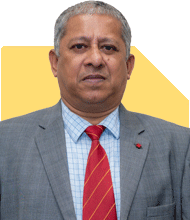Ramalingam Kalirajan |8231 Answers |Ask -Follow
Mutual Funds, Financial Planning Expert - Answered on Oct 26, 2024
He has an MBA in finance from the University of Madras and is a certified financial planner.
He is the director and chief financial planner at Holistic Investment, a Chennai-based firm that offers financial planning and wealth management advice.... more

Hi I have sell my house at 48 lakh. I have purched it 18 lakh. where shuld i have to invest these money for another 5-6 yers. I am 52 yers old.
Capital Gains Details: You sold your property for Rs 48 lakh, having initially purchased it for Rs 18 lakh. Since you held the property for more than two years, the profit qualifies as a long-term capital gain (LTCG).
Taxation on LTCG: The LTCG on property sales is taxed at 20% with indexation benefits. Another option is to pay 12.5% tax straight away without indexation. This tax may reduce if you opt for reinvestment options under Section 54 or Section 54EC of the Income Tax Act.
Section 54: If you reinvest in a new residential property within two years or construct one within three years, you could claim a tax exemption on the gains.
Section 54EC: If you don’t wish to reinvest in property, you can invest up to Rs 50 lakh in bonds issued by NHAI or REC, specifically designed for capital gains tax exemption. These bonds have a 5-year lock-in, and the interest is taxable.
2. Balanced Portfolio for Growth and Stability
Since you have a 5-6 year investment horizon, a balanced portfolio would be ideal to both grow and safeguard your funds. Consider a mix of the following investment categories:
Debt Mutual Funds for Stability and Safety
Stable Returns: Debt funds are less volatile than equity and offer relatively stable returns. They are suitable if you seek low-risk returns over a medium horizon.
Tax Efficiency: If held for more than three years, debt funds offer indexation benefits on LTCG, making them tax-efficient for medium-term goals.
Recommended Funds: Invest in short-to-medium duration debt funds to match your 5-6 year timeframe. Actively managed debt funds offer regular guidance from financial professionals, making them a better choice than direct investments.
Hybrid Funds for Balanced Growth
Hybrid Allocation: Hybrid funds blend equity and debt to provide moderate growth with stability, perfect for investors looking for balanced returns.
Risk Cushion: These funds protect you from market volatility with a mix of assets, ideal for 5-6 years of steady growth.
Tax Consideration: If held for over one year, equity-oriented hybrid funds benefit from LTCG tax treatment, which can be tax-efficient for your capital growth.
Actively Managed Equity Mutual Funds
Growth Potential: Even with a shorter timeframe, a limited allocation in equity mutual funds can provide enhanced returns. Actively managed funds, handled by expert fund managers, often outperform index funds, especially during market fluctuations.
Avoiding Direct Funds: Direct funds lack the insights a Certified Financial Planner (CFP) or Mutual Fund Distributor (MFD) offers. Regular plans offer guidance that can better align with your financial goals, helping you navigate market changes effectively.
Tax Structure: For equity funds, LTCG over Rs 1.25 lakh annually is taxed at 12.5%, which is lower than other asset classes, making it beneficial for growth.
3. Enhancing Liquidity with Debt Instruments
Having a portion of funds in fixed-return debt instruments ensures liquidity and regular income if needed. Here are a few options:
Fixed Deposits with Laddering: Spread deposits over multiple tenures, ensuring liquidity and minimising reinvestment risk due to fluctuating interest rates.
Corporate Bonds or NCDs: Consider bonds from reputed companies for fixed income, but focus on high-rated bonds for security. Although taxable, bonds provide consistent returns and can be an option for funds needed in a shorter span.
4. Emergency Fund Allocation
An emergency fund is vital at every age and is even more essential as retirement approaches. Secure at least 6-12 months of expenses in a liquid or ultra-short-term fund.
Liquid Funds: These provide quick access to cash if needed, with relatively lower risk and tax efficiency.
Bank Savings or Short FDs: For part of your emergency fund, keep funds in a high-yielding savings account or short-term fixed deposits.
5. Health and Retirement Provisions
As you are approaching retirement, securing adequate health and retirement funds is essential for a stable future.
Health Insurance: Ensure you have sufficient health insurance coverage, keeping in mind the rising medical expenses. You may also consider critical illness coverage to avoid out-of-pocket expenses.
Retirement Planning: Allocate a portion of your corpus in conservative, low-risk investments to provide consistent income post-retirement. Monthly Income Plans (MIPs) in mutual funds can supplement regular income if required, providing a balanced approach.
6. Potential Tax Liabilities and Strategic Planning
Here’s how to structure your investments while optimising tax efficiency:
Section 54 and 54EC: If you decide to reinvest under these sections, it can lower your capital gains tax liability. These are specific exemptions aimed at property sellers to reinvest gains in bonds or another house.
Indexation for Debt Funds: Holding debt funds for over three years qualifies for indexation, reducing your tax burden on long-term gains.
Regular Monitoring: A Certified Financial Planner can review your portfolio to adjust for tax efficiency, especially as new tax laws or changes affect mutual fund gains.
Final Insights
This is a solid time to capitalise on your property gains. With a mix of debt, equity, and hybrid mutual funds, you can achieve both stability and growth over the next 5-6 years.
Balanced Investment Strategy: A well-structured portfolio combining debt, hybrid, and limited equity mutual funds gives a balanced approach to growth and safety.
Tax Management: Maximising capital gains exemptions and using indexation benefits can help in optimising taxes on your gains.
Emergency and Health Planning: Set aside funds for medical and emergency needs, which is essential for financial peace.
By diversifying into the right instruments and with regular guidance, your Rs 48 lakh corpus can grow, while preserving your financial security over time.
Best Regards,
K. Ramalingam, MBA, CFP,
Chief Financial Planner
www.holisticinvestment.in
https://www.youtube.com/@HolisticInvestment
You may like to see similar questions and answers below
Ramalingam Kalirajan |8231 Answers |Ask -Follow
Mutual Funds, Financial Planning Expert - Answered on Apr 30, 2024
Ramalingam Kalirajan |8231 Answers |Ask -Follow
Mutual Funds, Financial Planning Expert - Answered on Jul 12, 2024
Ramalingam Kalirajan |8231 Answers |Ask -Follow
Mutual Funds, Financial Planning Expert - Answered on Aug 03, 2024
Ramalingam Kalirajan |8231 Answers |Ask -Follow
Mutual Funds, Financial Planning Expert - Answered on Apr 11, 2025
Prof Suvasish Mukhopadhyay |568 Answers |Ask -Follow
Career Counsellor - Answered on Apr 14, 2025
Nayagam P P |4431 Answers |Ask -Follow
Career Counsellor - Answered on Apr 14, 2025
Nayagam P P |4431 Answers |Ask -Follow
Career Counsellor - Answered on Apr 14, 2025
Nayagam P P |4431 Answers |Ask -Follow
Career Counsellor - Answered on Apr 14, 2025
Nayagam P P |4431 Answers |Ask -Follow
Career Counsellor - Answered on Apr 14, 2025
Nayagam P P |4431 Answers |Ask -Follow
Career Counsellor - Answered on Apr 14, 2025
Nayagam P P |4431 Answers |Ask -Follow
Career Counsellor - Answered on Apr 14, 2025
Nayagam P P |4431 Answers |Ask -Follow
Career Counsellor - Answered on Apr 14, 2025
Nayagam P P |4431 Answers |Ask -Follow
Career Counsellor - Answered on Apr 14, 2025
Ravi Mittal |571 Answers |Ask -Follow
Dating, Relationships Expert - Answered on Apr 14, 2025





















